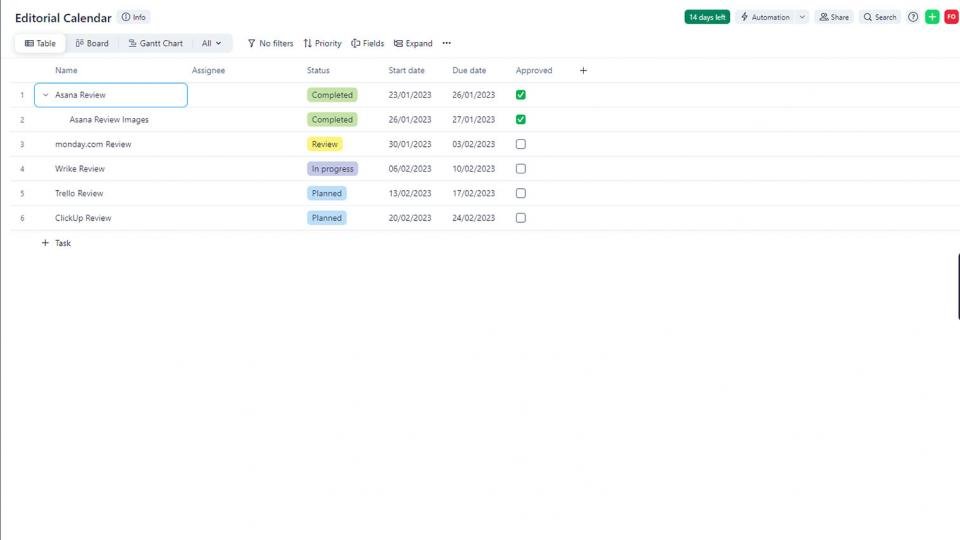
The best project management tools aid organisation and effective communication and ensure you get the job done
Project management software is designed to make your work easier, letting you better track your own tasks as well as those of your co-workers or employees. The best project management software is easy to use, comes with powerful features and, above all, is cost-effective.
There’s no shortage of project management software currently available, but working out which one offers exactly what you need is challenging. To help you make sense of the tools out there and, hopefully, speed up the purchasing process, we’ve tested more than a dozen programs to discover our pick of the best project management software available right now.
Best project management software: At a glance
- Best project management software overall: Asana | Check price
- Best budget project management software: ClickUp | Check price
- Best project management software for ease of use: Monday.com | Check price
Below, you’ll find our pick of the best project management software and tools you can buy today, based on our thorough testing and research. Our mini-reviews highlight the key strengths of each tool, but if you want more information, you can find our in-depth full-length reviews linked below. If you’re not sure where to begin, check out our detailed buying guide immediately below – or if you’re strapped for time, take a look at our at-a-glance list of the best project management software above.
How to choose the best project management software for you
How much should I spend?
Even with a list that’s been whittled down for you, you’ll still have to make some choices when coming to a decision about the best project management tool for you. There are a few places to start, with price maybe being the most obvious starting point.
The average price for a basic package of tools falls somewhere around £8 per user per month, with some providers going as low as £6 per user per month and others charging as much as £10 per user per month. Note that what’s included in each plan can also differ wildly.
More advanced packages can see a significant rise in price, with some software charging more than £20 per user per month. However, this will likely include some exotic high-level functionality that most small and medium-sized businesses probably won’t need. That said, almost all of our entries also offer some form of free plan that may suit those with more modest needs.
What features should I look for?
With plans ranging so wildly in price and the features they offer, you may want to take some time to assess the tools that you need before buying. All our picks offer the basics in some way, which we take to mean that they have a board, a list (or something like it) and a calendar or timeline. For most businesses, most of the time, this should be enough to run the majority of operations and thus keep prices low.
However, if you’re running a larger business or one that requires a lot of just-in-time movements, these tools won’t be sufficient on their own. You’ll need Gantt charts, employee tracking, future planning and a host of more advanced tools. Most of our picks deliver on this front, too, although the cost of the plans will rise accordingly.
Is ease of use an important consideration?
In a word, yes. All our picks offer excellent ease of use, although since this can be a subjective experience, we recommend that potential buyers take a potential purchase for a spin, either via a trial or a free plan, before committing.
How we test project management software
Testing project management software is as simple as creating a mock company with a made-up workload and then running operations through it for a week or so. Moving tasks around, assigning people to them, trying to send internal messages or attaching files – we do it all. This gives us a feel for how smoothly the program’s different components work together to deliver the outcomes for your company.
That’s the subjective part; there’s also the more difficult objective consideration that involves simply tallying what any software can do and then comparing it to the cost. All our picks offer good value for money; after all, the bottom line may be the most important thing of all.
The best project management software you can buy in 2023
1. Asana: Best project management software overall
Price: From £10/mth | View offers at Asana

Asana is our favourite project management tool for a few reasons. First, we love the interface, since it’s colourful and cheery. Not only does this raise the mood, it also helps you to more easily track tasks and figure out at a glance the stage at which any task is. This, together with smart design, makes Asana a great pick for any manager who wants a bird’s-eye view of what’s going on.
Asana has all the basics you need to handle projects big and small, and the software’s more advanced plans offer some unique tools that will enable larger businesses to easily manage multiple projects. It’s far from the only program to help large companies juggle multiple teams with a few clicks, but Asana is definitely one of the best.
However, all the above comes at a cost. It isn’t the most expensive option on the market, but nor is it cheap. It costs just under £10 per user per month for the Premium plan – the cheapest paid tier – with prices rapidly climbing from there. Thankfully, for small teams of up to 15 people Asana offers a free version, too.
- Read our full Asana review for details
- Find out more about Asana’s pricing and plans
- Asana vs Monday.com: The best tools, compared
Key specs – Free plan: Yes, for up to 15 users; Kanban board: Yes; List view: Yes; Gantt chart: Timeline only; Allows integrations: Yes; Built-in automations: Business plan only
2. ClickUp: Best budget project management software
Price: From £4/mth | View offers at ClickUp

ClickUp tries to be all things to all people, and comes a long way towards realising that. It features a great kanban board almost on a par with Trello’s, a friendly, intuitive interface, and maybe one of the best ways to handle subtasks that we’ve seen.
However, the above recommendation comes with some caveats. For one, its Gantt chart isn’t great, not allowing you to see those subtasks in a way that makes sense. Also, unlike many of the other entries on this list, it’s a little less flexible, making you use views that it feels are best, even if you have a different opinion.
However, those minor issues are balanced out by ClickUp’s friendly pricing. Not only does it have a solid free plan, it’s one of the very few project management tools to offer a cheap plan that’s aimed at users that require basic functions, but without any restrictions.
- Read our full ClickUp review for details
- We explain ClickUp’s pricing and plans
Key specs – Free plan: Unlimited users; Kanban board: Yes; List view: Yes; Gantt chart: Yes; Allows integrations: Yes; Built-in automations: Yes
3. Wrike: Best project management software for utility
Price: From £8/mth | View offers at Wrike

Wrike is another powerful tool, but it feels more workmanlike: its interface isn’t as attractive as Asana’s offering, and there’s something very old-school about it. Then again, that shouldn’t be too surprising since Wrike has been around for a long time.
As a result, Wrike is a tool that will appeal most to people who prefer their software without too many frills. Wrike comes packed with all manner of tools, including one of the better Gantt charts out there. The other boards are nothing to sneeze at, either, making Wrike very powerful.
Price-wise, Wrike sits at the bottom end of the market: its excellent free plan delivers all the basics at no cost, while the upgrade is a very reasonable £8 per user per month. However, this rate is only for teams of 25 people or fewer; any more than that and you’ll have to upgrade yet again at a whopping £22 per user per month, meaning Wrike is meant for either small businesses or very big ones.
- Read our full Wrike review for details
Key specs – Free plan: Yes, unlimited users; Kanban board: Yes; List view: Yes; Gantt chart: Yes; Allows integrations: Yes; Built-in automations: Team plans and up
4. Monday.com: Best project management software for ease of use
Price: From £9/mth | View offers at Monday.com

Monday.com is another solid all-rounder that incorporates a bit of everything. It’s colourful like Asana, offers the power of Wrike, and still offers the ease of use of ClickUp. We found it a breeze to use, although it had some shortcomings when it came to advanced functions.
Still, for organisations that need to manage multiple tasks, Monday.com may be just the ticket. All its views work extremely well together and offer great customisation, meaning you can order and rank tasks as you see fit on the fly, making it perfect to check on priorities as well as future events.
However, there is one issue with Monday.com – its somewhat confusing pricing. Currently, it offers five plans, the first two of which aren’t very useful: the first has very little meat on the bone, even for a free plan, while the Basic plan can barely be described that way. As a result, Monday.com only starts to get interesting at the Standard tier, which costs £9 per user per month.
- Read our full Monday.com review for details
- Monday.com pricing and plans, explained
- Monday.com vs Asana: Which is best for your business?
Key specs – Free plan: Yes; Kanban board: Yes; List view: Yes; Gantt chart: Yes; Allows integrations: Starting from Standard plan; Built-in automations: Starting from Standard plan
5. Trello: Best project management software for kanban
Price: From £4/mth | View offers at Trello

Unlike most of the entries on this list, Trello is a much more specialised tool, with the best kanban board on the market. While it does offer other functionality, too, this feels a little tacked-on to be truly useful. However, its board can’t be beaten for ease of use and utility. It’s just that good.
If you need more than just a board, Trello is still a good option as a result of its offering of plugins. They’re easy to install with its power-up system, which is basically a shopping list of all the different plugins you can use. You can add lists, calendars – whatever you need to augment the board.
Interestingly, all this is offered for free, making Trello an odd duck on this list since it may be the only one for which you’re actually better not paying. Trello’s paid plans offer some extra doodads, but you can easily add these as a free power-up, so there’s no good reason to pay. Which is great – because we found the paid plans to be rather pricey considering what you get from them.
- Read our full Trello review for details
- Trello pricing: Everything you need to know
- Trello vs Asana: Which should you buy?
Key specs – Free plan: Unlimited users; Kanban board: Yes; List view: No; Gantt chart: No; Allows integrations: Yes; Built-in automations: Yes
